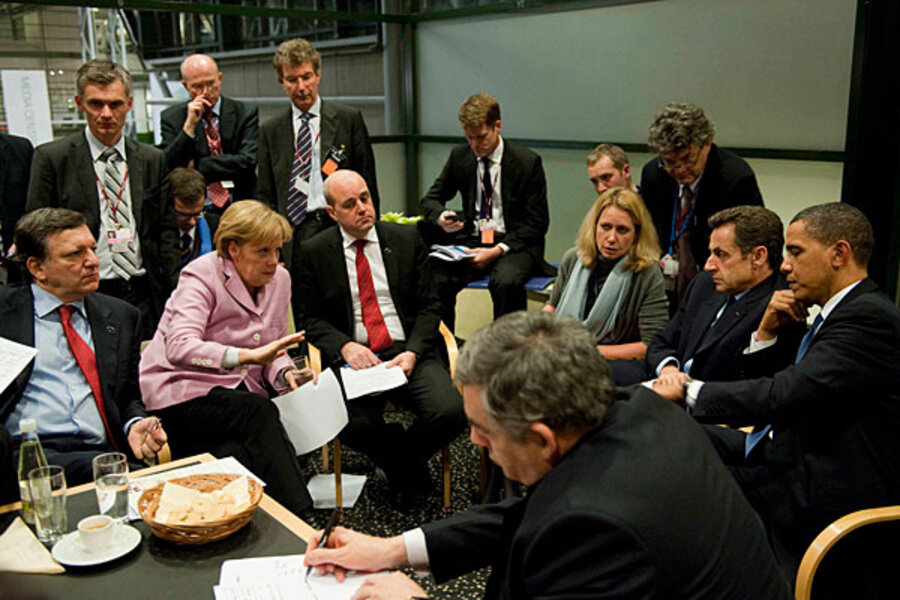Copenhagen accord: 'essential beginning' to some, shaky foundation to others
Loading...
| Copenhagen,Denmark
Ministers from more than 190 countries approved a new climate agreement today that lays out emissions-control objectives for the US and a range of developing countries, sets a target of less than 2 degrees for global warming, and pledges $30 billion in aid for adaptation and other climate-related needs for developing countries.
The deal first emerged yesterday after leaders from 28 countries backed the accord, which was negotiated by the US, China, Brazil, South Africa, and India. The goal was to have the pact adopted by all the countries taking part in two weeks of global climate negotiations here.
But the agreement left many observers disappointed – and laid bare the challenges of negotiating a climate agreement among 193 countries with such a broad range of political and economic interests, and with such diverse levels of economic development.
The pact that was agreed to today barely survived last-minute objections in an all-night plenary session aimed at gaining the needed consensus to become an official adjunct to the 1992 Framework Convention on Climate Change. Only after UN Secretary-General Ban Ki-moon and a group of international lawyers intervened with a last-minute word change did negotiators unanimously accept the pact.
The result: a pact countries can sign up for if they want to, once they've had time to study closely its provisions and get comfortable with them. A large number of countries do indeed want to be in on the pact, because of the climate aid package it contains.
Secretary Ban acknowledged that negotiators "did not get everything that everyone hoped for." But, he added, the pact "is an essential beginning. It lays the foundation for the first truly global agreement" on climate."
Not legally binding
To many negotiators, especially from developing countries, it is a shaky foundation. The pact is not legally binding, although negotiators will try to craft formal treaty language over the next year. The emission-control efforts countries have included in the agreement falls well short of the emissions reductions the UN-sponsored Intergovernmental Panel on Climate Change indicates is needed to achieve a 2-degree goal. And long-term financing provisions to help developing countries adapt to global warming and afford the green technologies they will need to keep their emission-control pledges is too vague for many.
During the morning's plenary debate, the head of the delegation from the Marshall Islands lamented that he would "leave this conference with a sense of loss and sadness." The highest spot among the islands that make up the Marshalls is only about 7 feet above sea level, he explained. The 2-degree goal, he continued, is insufficient to prevent sea levels from eventually rising high enough to swamp most of the islands. "My country is one of the biggest losers in this exercise," he said.
European Union officials, who had dangled aggressive emissions cuts as an incentive for others to offer up more ambitious emission-control, also viewed the pact with a level of resignation.
"This is not a perfect agreement," said Fredrik Reinfeldt, Sweden's prime minister and Eu president. "But this agreement among major players is a start."
Fast-start financial aid for developing countries
One element that helped the agreement along involved so-called fast-start financial aid to developing countries for adaptation and climate-friendly development. The agreement sets up the Copenhagen Green Fund, into which developed countries will put $30 billion between 2010 and 2012.
If the pact itself leaves many here lukewarm at best about the results, the process does herald a potential change in the way international negotiations are handled, notes Harvard University's Robert Stavin, who heads Harvard's Project on International Climate Agreements.
Heads of government clinched the deal
In essence, the most critical negotiations ultimately were conducted and concluded by heads of government themselves, rather than their ministers.
Indeed, Ban's intervention today in effect acted as a coda to the involvement of such top global politicians. It's a level of engagement seldom if ever seen in any global negotiating forum, adds Robert Orr, the UN's assistant secretary-general for policy and planning.
Usually deals are precooked and leaders smile and sign, he says. This time around, leaders were actively engaged, negotiating in ways they hadn't since their early days as politicians. Leaders were exploring temperature goals with a level of understanding that Mr. Orr says he's never heard before from people at that level.
"Two years ago, I'm not sure that there were but a handful of leaders ... that could have a meaningful discussion on 1.5 versus 2 degrees," he says.
But the talks reopened rifts between rich and poor countries that have flared since the end of colonialization during the last century. It wasn't lost on observers that the deal was struck among countries taking part in Washington's Major Economies Forum on Climate and Energy, a legacy of the George W. Bush presidency.
The next, and perhaps more difficult task, is to fill in the blanks and work out language that yields a legally binding agreement, says Yvo de Boer, the executive secretary of the UN Framework Convention on Climate Change. "We've got to achieve in Mexico ll the things we were supposed to achieve here," he said. That includes a legally binding treaty that embraces the US as well as the financial aid provisions, adequate provisions for technology transfer, and other items that dropped from the screen as one draft accord morphed into another. And he looks for results that ensure the 1997 Kyoto Protocol moves into a second commitment period.
"Basically, the list I put under the Christmas tree two years ago I can put under the Christmas tree again," he says.





